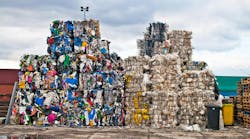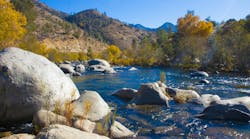The natural banks of Fred Creek in Tulsa, Okla., began eroding during storm events, threatening to undermine several nearby bridges and footings for utility lines. The natural banks of the creek were no longer adequate for containing floods.
Tulsa’s growth had created similar issues across the city, and officials were faced with a daunting challenge: find an aesthetic channel solution that could solve the erosion issue while following the natural lay of the land. Since this project was only the first phase of drainage improvements, the city also needed a solution for multiple applications across Tulsa.
Reaching a Solution
The soils along the creek were composed of fine “sugar” sand in many places making it highly susceptible to erosion, Tetra Tech Lead Design Engineer Ryan Mittasch explained.
Several options, including natural stone and poured-in-place walls were considered, but the city ultimately chose Redi-Rock wet-cast retaining walls as the best solution based on several key factors:
-
Design flexibility: The city’s goal was to widen the banks of Fred Creek while following the natural slope of the existing channel as closely as possible. With standard Redi-Rock blocks, engineers were able to design inside and outside curves with 90-degree corners and even abut culverts without requiring custom components. The curves allowed walls to follow the natural lay of the land and also to slow water to prevent erosion.
-
Multiple batter options: The ability to modify the batter angle of the channel at various points also allowed the Redi-Rock channel to match the natural slope of the existing channel. Redi-Rock walls have several batter options, including a 26.6-degree batter angle created by 9-in. setback blocks, a zero-degree batter option and four-degree batter option using standard Redi-Rock blocks. These blocks can coordinate to create custom batter angles to suit a site’s needs. A major portion of the Fred Creek channel was built using 9-in. setback blocks. Since each course of the wall steps back 9 in., the staircase design of the walls also provided a more hospitable habitat for plants and animals—and a safer escape route if someone fell into the channel.
-
Aesthetics: According to landscape architect Mike Peters of Alaback Design Associates, “Appearance at this site was especially important because it goes right through an urban campus with walking trails. We needed a natural looking material that’s also functional, which is where Redi-Rock fit in.”
The city chose Redi-Rock limestone texture walls to match the scale of the project and provide an aesthetic finish for the channel. Redi-Rock is also available in cobblestone and ledgestone textures.
-
Local availability: SI Precast manufactured the Redi-Rock blocks for this project only seven miles from the construction site, cutting the freight cost and delivery times. More than 125 Redi-Rock manufacturers are located across the U.S. and Canada and are within reach of nearly every major market.
Installing Gravity and Reinforced Walls
“Even with the geogrid, the walls were quicker to install than poured-in-place because we could just set the blocks instead of having to form and pour, form and pour,” said Crossland Heavy Construction employee Chris Walters.
The city of Tulsa’s drainage improvements are taking place over several phases. This phase encompassed a total of 68,000 sq ft of gravity and reinforced retaining walls.
A Repeat Customer
Tulsa’s project manager said the city is continuing to work with large block retaining walls for erosion control needs throughout the city, such as with the Joe Creek Channel project that was completed in 2009.

